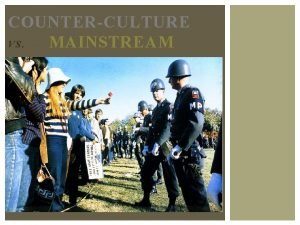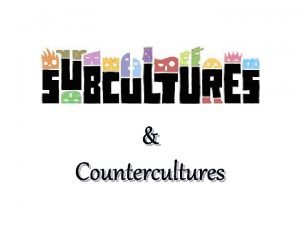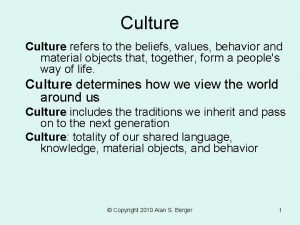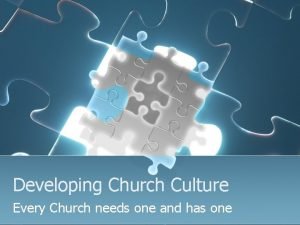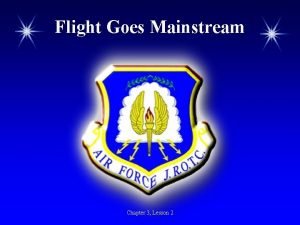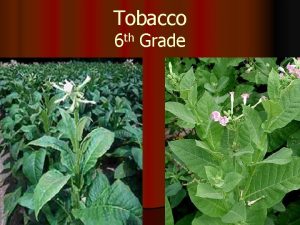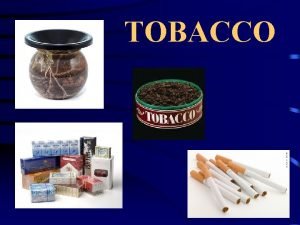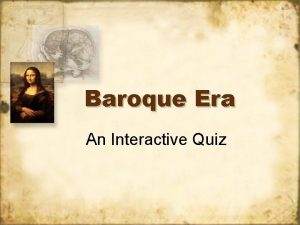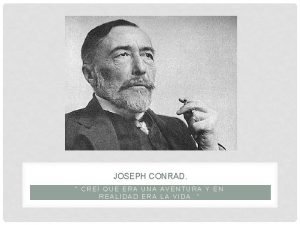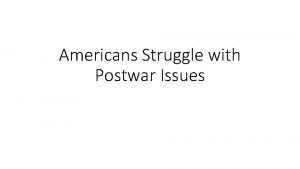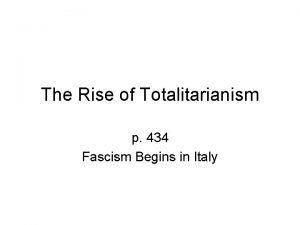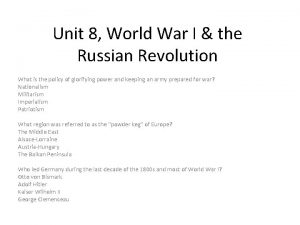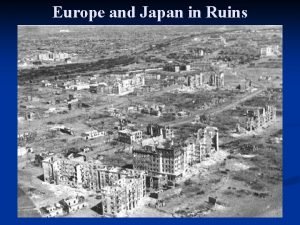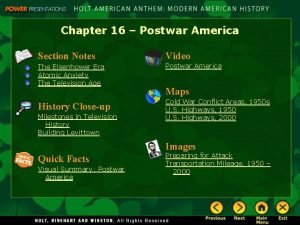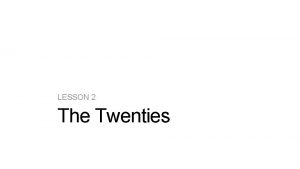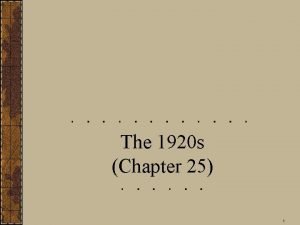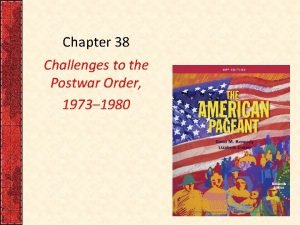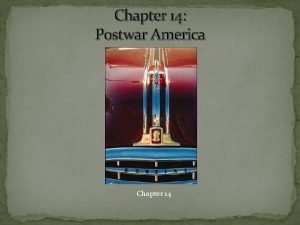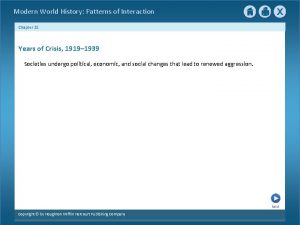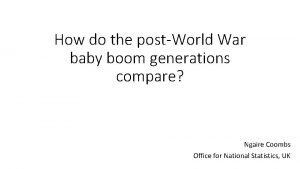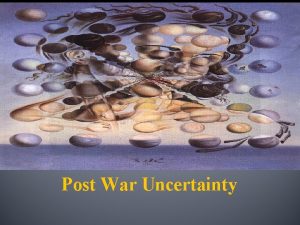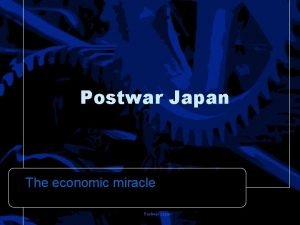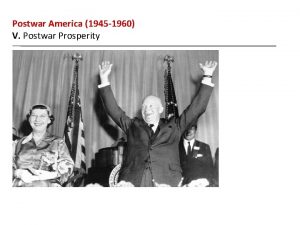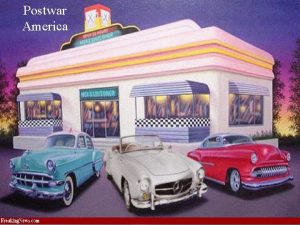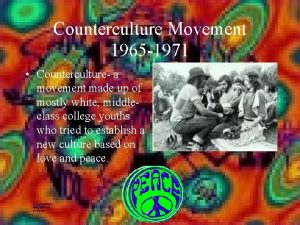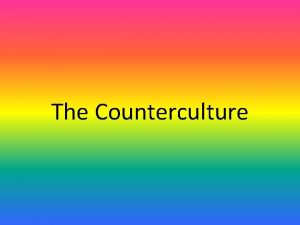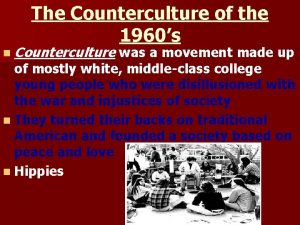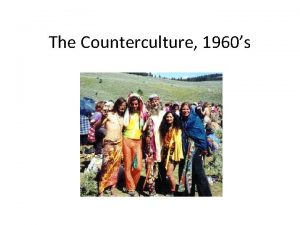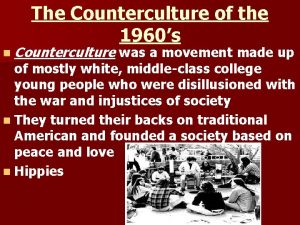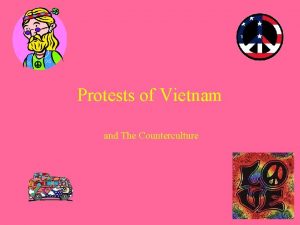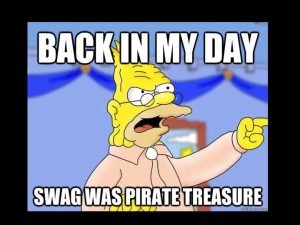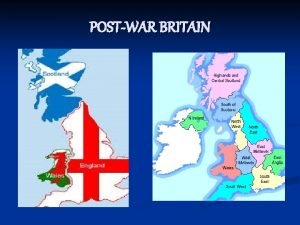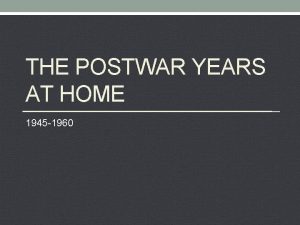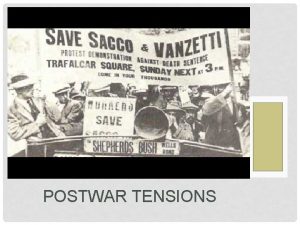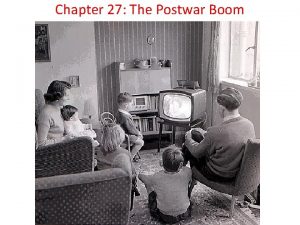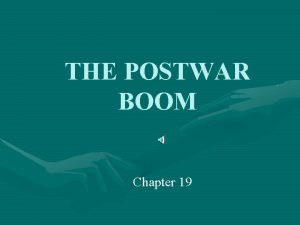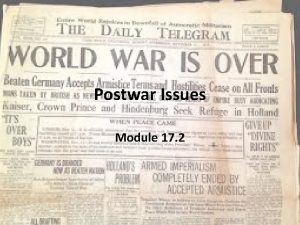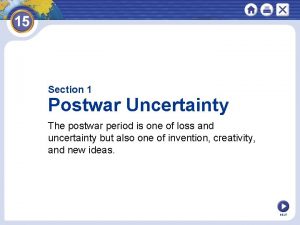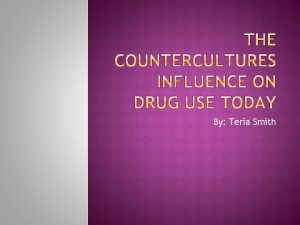COUNTERCULTURE VS MAINSTREAM MAINSTREAM CULTURE The postwar era
































































- Slides: 64

COUNTER-CULTURE VS. MAINSTREAM

MAINSTREAM CULTURE The postwar era of 1945 -1960 was a time of amazing econ growth & prosperity for millions of Ams These Ams- adult, mostly white, middle & upper class- were the mainstream of the population § Survived Great Depression, fought WWII, & now expected lives of peace § They moved to suburbs, found good jobs, began families, assuming their children would go to college and have even better lives than they did 4 concepts typified Mainstream America: § They were very patriotic (“America: Love it or leave it. ”) § They believed in the institution of marriage (You fall in love, you get married. ) § They believed in the American Dream (Work hard and you can have a good life) § They believed conformity kept society ordered (fashion, jobs, behavior, etc)

THE COUNTERCULTURE In the ’ 60 s, group of mostly young, white Ams born just after the war began challenging est’d mainstream values Eventually known as the counter-culture, this movement stressed pursuit of personal freedom & alternative lifestyles, rebellion against conformity & materialism. Worked to stop racism, war, & poverty 6 ideas typified this movement § Communal living § Experimental Drug Use § Scandalous Fashions § Political Activism § New Music Styles § Sexual liberation/revolution


COMMUNAL LIVING Many c-c youth moved to city centers like San Fran’s Haight. Ashbury District & NYC’s East Village, but another segment of the c -c left the city altogether & set up communes in isolated places in the mountains of CA or NM They attempted to live their lives based on cooperation & love, to live in harmony w/ nature, not conquer it Despite moving to communes for equality and a new lifestyle, many women still found themselves in the same positions they had been in society


EXPERIMENTAL DRUG USE For many c-c youth, drug use was an important part of rebellion & personal freedom While marijuana was most popular, the mind-altering LSD (lysergic acid diethylamide) or “acid” was increasing in use. § Harvard professor Timothy Leary urged people to “tune in, turn on, & drop out”- a phrase that became a motto for c-c members to experiment with drugs to achieve new “states of consciousness” As drugs grew in popularity, newspapers & schools pointed out the increasing numbers of youth dying from drug overdoses C-C members were quick to point out the mainstream drug of choice: alcohol


SCANDALOUS FASHIONS Calling themselves hippies (from the expression “hip”), c-c youth dressed in outrageous clothing designed to shock mainstream society They wore: Beads (both men & women) Tie-dyed shirts (both men & women) Men wore fringe jackets & army surplus Women wore both mini-skirts & peasant skirts with blouses designed to show midriffs (& they also went braless) Long hair was the norm for both men & women



NEW MUSIC STYLES The folk, pop, & rock music of the 1960 s also challenged mainstream values. § Bob Dylan’s folk songs, like The Times They Are A-Changin’, became c-c anthems, promoting social justice. § The Beatles sang about a “Revolution” inspiring youth to change their world, while Joni Mitchell sang about preserving nature in Big Yellow Taxi § By late 60 s, psychedelic rock was in vogue w/groups like Jefferson Airplane, Jimi Hendrix, & the Doors, Led Zeppelin heavy guitar & explicit sex & drug references In ’ 69, these elements all came together at a farm in NY at the Woodstock festival. More than 500 K people came together to camp out, take drugs, engage in free love, & listen to rock

SEXUAL REVOLUTION The ’ 60 s saw a revolution in the realm of human sexuality and the c-c was largely responsible for it. The c-c scoffed at their parents’ values & called them sexually repressed. They called for “free love” or casual sex. Medical advances, like the birth control pill, made sexual activity without fear of pregnancy easier. Soon the country was seeing the effects of this “new freedom”- women went braless, movies showed sex b/t men and women, & songs made explicit references to sex It should also be noted that the gay rights movement began as a result of this new freedom There was also an incredible rise in STDs &, despite improved birth control, illegitimate children born

FALL OF THE COUNTER-CULTURE “The history of the Haight-Ashbury section of San Francisco illustrated the problems caused by drugs. In 1967, Haight was the center of the counterculture, the home of the flower children. In the "city of love, " hippies ingested LSD, smoked pot, listened to "acid rock, " and proclaimed the dawning of a new age. Yet the area was suffering from severe problems. High levels of racial violence, venereal disease, rape, drug overdoses, and poverty ensured more bad trips than good. ”

FALL OF THE COUNTER-CULTURE Even music, which along with drugs and sex formed the counterculture trinity, failed to alter human behavior. In 1969, journalists hailed the Woodstock music festival as a symbol of love. But a few months later, a group of Hell's Angels violently interrupted the Altamont Raceway music festival. As Mick Jagger sang "Under My Thumb, " an Angel stabbed a black man to death. Like the New Left, the counterculture fell victim to its own excesses. Sex, drugs, and rock-and-roll did not solve the problems facing the United States. And by the end of the 1960 s, the counterculture had lost its force.


POLITICAL ACTIVISM For most of the mainstream, the c-c & the anti-war movement were inseparably linked By late ’ 60 s, the TV was showing images of long-haired protestors marching against the Vietnam War Despite what most Americans thought, the antiwar movement was not easily categorized § Some were confrontational- burning the flag, cursing & goading police or Nat Guard troops § Others were interested in making a peace statement- marching in silence, carrying peace signs, placing flowers in the barrels of govt troops to prove their pacifism These distinctions were lost on mainstream America who saw them all as “filthy, long-haired, drugged-up, & disloyal. ”

WERE THE ANTI-WAR PROTESTS OF THE 60’S AND 70’S EFFECTIVE IN CONVINCING THE AMERICAN PUBLIC THAT THE WAR IN VIETNAM SHOULD BE ABANDONED?

THE FIRST D. C. RALLY April 17, 1965 § One month after the U. S. sent its first troops to Vietnam § Staged by the Leftist group, Students for a Democratic Society § 16, 000 people picketed outside the White House § “No More War” § “We Want Peace Now” § Only 4 arrests made

MARCH ON THE PENTAGON October 21, 1967 § Culmination of 5 days of protests organized by the National Mobilization Committee to End the War in Vietnam § Famous speakers came to address the crowd (Robert Lowell, Benjamin Spock) § The protest escalated when the leaders of the Youth International Party announced they were going to “exorcise” the Pentagon § People surrounded the building and chanted spells to try and drive out the “evil war spirits” § “LBJ, Pull Out Now, Like Your Father Should Have Done. ” § Tear gas was released into the crowd § 2, 500 troops guarded the Pentagon § 681 arrested

MARCH ON THE PENTAGON (CONT. )

THE MORATORIUM RALLY November 15, 1969 (D. C. ) § America’s biggest anti- war demonstration ever § 250, 000 - 500, 000 protestors present § A little less wild § LBJ was out of office and Nixon had initiated his “Vietnamization” plan § Police had learned how to handle protests § § 3, 000 Police 9, 000 Army troops 200 Lawyers 75 Clergymen § Protest was peaceful for the most part § 135 arrests made

THE MORATORIUM RALLY (CONT. ) The Moratorium Rally was the largest anti-war protest in U. S. history

KENT STATE In response to Nixon’s invasion of Cambodia § Didn’t want to be drafted May 1, 1970 - Day One § § Huge demonstration on the College’s commons Around midnight rowdy bikers began throwing bottles and vandalizing cars in the street Approximately 100 students joined in Police eventually got the situation under control

KENT STATE (CONT. ) May 2, 1970 - Day Two § State of Emergency declared in Kent § Ohio Governor, James A. Rhodes, called in the National Guard § Demonstrations continued on campus § Reserve Officer Training Corps building was set on fire § Fire men and police were pelted with rocks by the surrounding crowd § 10: 00 p. m. - National Guard set up camp on Kent State’s campus § Used tear gas and arrested the protestors § At least one person was bayoneted May 3, 1970 - Day Three § More protests § Curfew imposed on students

KENT STATE (CONT. ) The National Guard was sent in to maintain order on Kent State’s campus

KENT STATE (CONT. ) May 4, 1970 - Day Four § Pre-planned rally commenced § Approx. 2, 000 people present § National Guard told them to disperse § People refused § Troops sprayed the crowd with tear gas § Crowd began throwing rocks and chased the National Guard off campus § “Pigs off Campus!” § After being chased up a hill by the angry protestors, the National Guard opened fire on the crowd § Firing lasted 13 seconds § 4 dead § 9 wounded

KENT STATE (CONT. ) The National Guard was chased up a hill by angry students A shocked student grieves over a dead body, shot down by the National Guard

FOURTH D. C. RALLY In response to Nixon’s invasion of Cambodia and the Kent State shootings Goal: Close down Washington D. C. on May 3, 1971 § Shut off all access routes to the city § The protestors would come in waves so if one wave got arrested the next would be there to take its place § March on the Pentagon, the Capitol, and the Justice Department Two weeks before May Day, 1971 § Over 200, 000 people attended peaceful rallies in D. C. § As May 3 approached many left, leaving only the die- hard radicals (organized by the People’s Coalition for Peace and Justice)

THE FOURTH D. C. RALLY (CONT. )

THE FOURTH D. C. RALLY (CONT. ) As May 3 approached, the Police prepared to arrest huge numbers of people § Fill- in- the- blank arrest forms (to arrest people faster) § Polaroid cameras would be used to take pictures of perpetrators so the Policeman could remember him later in court § New “flexi- cuffs” with officer’s badge number already on them § “Arrest teams” created to streamline the arresting process § Arresting officer § Handcuffing officer § Transporting officer

THE FOURTH D. C. RALLY (CONT. ) May 2, 1971 § Police announced over a loudspeaker that the 30, 000 protestors camping out in West Potomac Park must vacate § Reason: “violation of their permit” (use of drugs) § Only 12, 000 people remained after the announcement May 3, 1971 § Police used tear gas to keep streets open § 7, 000 people arrested- the record to date § 155 injuries § Protestors plan was thwarted and D. C. stayed open

PROTESTS WERE EFFECTIVE (CONT. ) In view of developments since we entered the fighting in Vietnam do you think the U. S. made a mistake sending troops to fight in Vietnam? " (Gallup) DATEPERCENT Percent that said NO August 1965: 61 March 1966: 59 May 1966: 49 September 1966: 48 November 1966: 51 February 1967: 52 May 1967: 50 July 1967: 48 October 1967: 44 December 1967: 46 February 1968: 42 March 1968: 41 April 1968: 40 August 1968: 35 October 1968: 37 February 1969: 39 October 1969: 32 January 1970: 33 April 1970: 34 May 1970: 36 January 1971: 31 May 1971: 28

PROTESTS WERE EFFECTIVE (CONT. ) Date: 12/1974 Sample: National Sample of Persons 18 or older Question Number: 2. As a result of what we learned from the Vietnam War, do you tend to agree or disagree that (READ LIST AND RECORD BELOW FOR EACH ITEM)? Item: We should never again commit American soldiers to a war like Vietnam Responses: Agree/Disagree/Not Sure Weighted Percent Responding § § 75. 40% Agree 18. 10% Disagree 6. 50% Not Sure Number of Valid Cases: 2864 SAS/SPSS Variable Name: Q 2_4

OPINION #2: PROTESTS WERE NOT EFFECTIVE Protesters of the time were so radical they repelled others § “Negative Follower Group”- One group of people (protesters) bothers the other (normal Americans) to the point where others join the enemy (Pro-war Americans) It was not the protests that changed public opinion, but the constantly increasing amount of money being spent on the war

PROTESTS WERE NOT EFFECTIVE (CONT. ) Date: 06/1965 Sample: VOTERS Question Number: 11 e. Do you think the disagreement of college professors and students with U. S. policies in Vietnam is mainly the result of honest disagreement, or do you think it is mainly the result of organized radical activity in colleges today? Responses: Honest disagreement/Radical activity/Not sure Unweighted* Percent Responding § § 25. 90% Honest disagreement 56. 30% Radical activity 17. 70% Not sure Number of Valid Cases: 158 SAS/SPSS Variable Name: Q 11 E * Weights not available for this survey

PROTESTS WERE NOT EFFECTIVE (CONT. ) Date: 10/1969 Sample: National Sample of Persons 16 or older Question Number: 5 c. Do you favor or oppose an immediate withdrawal of all American troops from Vietnam? Responses: Favor/Oppose/Not sure Unweighted* Percent Responding § § 35. 90% Favor 56. 50% Oppose 7. 60% Not sure Number of Valid Cases: 1636 SAS/SPSS Variable Name: Q 5 C * Weights not available for this survey

WERE THE ANTI-WAR PROTESTS OF THE 60’S AND 70’S EFFECTIVE IN CHANGING PUBLIC OPINION ABOUT THE WAR IN VIETNAM? You Decide!

NIXON YEARS

The First Moon Landing l During Nixon’s presidency, the United States achieved its goal of a successful moon landing. l On July 20, 1969, Neil A. Armstrong became the first man to walk on the moon. He was joined by Edwin E. “Buzz” Aldrin, Jr. , a fellow crewman on the Apollo 11 spacecraft. l Television viewers around the world watched the moon landing, and Apollo 11’s crew were treated as heroes when they returned.

Nixon’s Domestic & Economic Policies • Stagflation: Stagflation described as a period of high inflation combined with economic stagnation, unemployment, or economic recession that occurred during the 1970 s. • Stagflation is thought to occur when there is an adverse shock (a sudden increase, say in the price of oil) Stagflation Response • Taxed imports to help balance of trade • Helpless to stop OPEC (Organization of Petroleum Exporting Countries) from oil embargo in retaliation for Israeli support • Issues wage and price controls to reduce inflation and spur job growth • Goes off gold standard to lessen dollar and bolster US products overseas

Watergate & Other Scandals l Growing Cynicism with Government l Watergate Scandal Pentagon Papers = New York Times vs. US Govt. l CREEP, the “plumbers”, and the enemies list l l Committee to Re-elect the President Senate Investigation = Impeachment charges l Resignation on August 9, 1974 l Aftermath l l Succeeded by Gerald R. Ford

Battling Political Enemies l l l Nixon’s suspicious and secretive nature caused the White House to operate as if it were surrounded by political enemies. One result of this mind-set was the creation of an “enemies list, ” a list of prominent people seen as unsympathetic to the administration. When someone in the National Security Council appeared to have leaked secret government information to the New York Times, Times Nixon ordered that wiretaps, wiretaps or listening devices, be installed on the telephones of some news reporters and members of his staff. Leaks to the press continued, including former Defense Department official Daniel Ellsberg’s leak of the Pentagon Papers, Papers a government study that revealed widespread deception about the situation in Vietnam. In response, Nixon organized a special White House unit, nicknamed the Plumbers, to stop government leaks. In September 1971, the Plumbers broke into the office of Ellsberg’s psychiatrist, hoping to punish Ellsberg by

PENTAGON PAPERS

• In June 1971, Daniel Ellsburg leaked the Pentagon Papers to the NY Times • A detailed study of US policy in Vietnam commissioned in 1967 • Showed US leaders had lied to the American people about not wanting to expand the • President Nixon felt National was Vietnam Security War but did. threatened. • Nixon was successful in obtaining a court order to stop publication but New York Times filed a lawsuit citing free press issues and violating no prior restraint • Nixon ordered Ellsburg’s psychiatrist’s office

• Ellsberg was charged with 12 felony counts under the Espionage Act • Carried a maximum sentence of 115 years. • The charges against Ellsberg and Anthony Russo (who helped him photocopy the papers) • Charges were dismissed in the fifth month of the trial. • On grounds of governmental misconduct due to illegal wiretapping and evidence tampering.

Nixon’s Reelection Campaign Funding “Dirty Tricks” l Attempts to sabotage The Committee to Nixon’s political opponents Reelect the President, came to be known as “dirty led by John Mitchell, tricks. ” These efforts aimed to collect as much included sending hecklers campaign money as to disrupt Democratic possible before a new law campaign meetings and required such assigning spies to join the contributions to be campaigns of opposing reported. candidates. l The money that the Committee collected was l One particularly damaging “dirty trick” involved a faked intended to fund both routine campaign activities letter that seriously hurt the candidacy of Edmund and secret unethical Muskie, a leading actions. Democratic presidential l

PLUMBERS v Nixon established a secret group known as the plumbers to plug leaks v Started campaign of dirty tricks that included IRS harassment and derailing of Democratic frontrunner Edmund Muskie. v Used methods as calling New Hampshire voters in the middle of the night and claiming to be from Harlem for Muskee or putting signs around Florida stating “Help Muskee in busing more children now” v Funded by Committee to Re-Elect the President (CREEP) which used highly questionable fund raising tactics and raised over $20 million

The Watergate Break-In In March 1972, a group within the Committee to Reelect the President made plans to wiretap the phones at the Democratic National Committee Headquarters at the Watergate apartment complex in Washington, D. C. l This group was led by E. Howard Hunt and G. Gordon Liddy. The group’s first attempt failed. During their second attempt on June 17, 1972, five men were arrested. l The money they carried was traced directly to Nixon’s reelection campaign, linking the break-in to the campaign. l The break-in and the cover-up which resulted became known as the Watergate scandal. l

WATERGATE BREAK IN v Some of the money raised by CREEP went to pay for the break in at the Democratic Headquarters located in the Watergate Hotel in Washington v 5 burglars caught June 17, 1972, carrying cameras, wiretapping equipment and large amounts of cash v Nixon administration denied any knowledge v Burglars were convicted in January 1973 and, despite offers of $400 K in hush money from White House Counsel John Dean, one of the burglars started to talk v At same time, reporters Carl Bernstein and Bob Woodward began to expose cover-up


The Watergate Coverup Although Nixon had not been involved in the break-in, he became involved in its coverup. l He illegally authorized the CIA to try to persuade the FBI to stop its investigation of the break-in, on the grounds that the matter involved “national security. ” l Nixon advisors launched a scheme to bribe the Watergate defendants into silence, as well as coaching them on how to lie in court. l During the months following the break-in, the incident was barely noticed by the public. Nixon won the 1972 election by a landslide. l

The Scandal Unfolds The Watergate Trial l At the trial of the Watergate burglars in early 1973, all the defendants either pleaded guilty or were found guilty. l Judge John J. Sirica, presiding over the trial, was not convinced that the full story had been told. l He sentenced the burglars to long prison terms, suggesting that their terms could be reduced if they cooperated with upcoming Senate hearings on Watergate. Woodward and Bernstein l Two young Washington Post reporters, Bob Woodward and Carl Bernstein, were influential in tracking down information to uncover the Watergate story. l Woodward and Bernstein believed that the White House would prove to be involved in the Watergate scandal.

WATERGATE v In February 1973, the Senate voted to establish a select committee to investigate the scandal v In April, 3 of Nixon’s top aides resigned after their implication and Dean, who was getting nervous, was fired while press secretary Ron Zeigler declared all previous statements on the subject “inoperative”

The Scandal Unfolds A Secret Taping System The Senate Investigates l Aided by Woodward and l During the Senate Bernstein and by the hearings, Alexander testimony of one of the Butterfield, a former Watergate burglars, a presidential assistant, Senate Select Committee revealed the existence of on Presidential Campaign a secret taping system in Activities began to the President’s office. investigate the Watergate l The taping system had affair. been set up to provide a l Millions of Americans historical record of watched the Senate Nixon’s presidency. Now hearings unfold on national it could be used to show television. whether or not Nixon had l Nixon attempted to protect been involved in the himself by forcing two top Watergate coverup. aides to resign and by

WATERGATE v In May, the Senate Watergate Committee chaired by Sam Ervin of North Carolina began nationally televised hearings v On June 14, Jeb Magruder, former Asst. Sec of Commerce, confessed his guilt and implicated Attorney General John Mitchell, John Dean and others v Dean then implicated Nixon and an aide revealed that there was a secret taping system in the White House

The “Saturday Night Massacre” In an effort to demonstrate his honesty, in May 1973 Nixon agreed to the appointment of a special prosecutor for the Watergate affair. l A special prosecutor works for the Justice Department and conducts an investigation into claims of wrongdoing by government officials. l The Watergate special prosecutor, Archibald Cox, insisted that Nixon release the White House tapes. l Nixon ordered him fired on Saturday, October 20, 1973, beginning a series of resignations and firings that became known as the “Saturday Night Massacre. ” l

SATURDAY NIGHT MASSACRE v Nixon stonewalled turning over tapes citing executive privilege and national security v Special Prosecutor Archibald Cox successfully petitioned a lower court to force Nixon to hand over tapes v Nixon refused and ordered Attorney General Elliott Richardson to fire Cox v Richardson refused and resigned as did Asst. AG William Ruckelshaus v Third in line, Solicitor General Robert Bork complied v Became known as Saturday Night Massacre and sparked outrage and new demands for tapes v Finally after new round of subpoenas, Nixon released heavily edited transcripts in spring of 1974 included a suspicious 18 minute gap

An Administration in Jeopardy Problems in the Nixon Administration, 1973– 1974 l Nixon’s public approval rating plummeted after his firing of Cox. l When Cox’s replacement, Leon Jaworski, also requested that Nixon turn over the tapes, Nixon turned over edited transcripts instead. Feelings of anger and disillusionment arose among many who read them. l Vice President Spiro Agnew, accused of evading income taxes and taking bribes, resigned in early October 1973. His successor, Gerald Ford, was not confirmed until two months later.

Impeachment Hearings and Nixon’s Resignation After the Saturday Night Massacre, Congress began the process of determining if they should impeach the President, or charge him with misconduct while in office. l In the summer of 1974, the House Judiciary Committee voted to impeach Nixon on numerous charges. Conviction, and removal from office, seemed likely. l On August 5, 1974, Nixon released the White House tapes, with an 18 1/2 minute gap. Even with this gap, the tapes revealed his involvement in the Watergate coverup. l On August 9, 1974, Nixon resigned, the first President ever to do so. Gerald Ford was sworn l

IMPEACHMENT v In summer of 1974, a committee of the House convened to consider impeachment v On July 30, 7 Republicans joined Democratic majority to vote three articles of impeachment − obstruction of justice − abuse of power − subverting the Constitution v 2 days later, Supreme Court ruled that Nixon had no right to claim executive privilege as justification for turning over additional tapes v On August 5 Nixon released the unexpurgated tapes which contained shocking evidence that he had ordered the cover up as early as 6 days after the break in

RESIGNATION v A delegation of the most senior members of Congress, led by Barry Goldwater, informed the President that no more than 15 Senators still supported him v On August 9, 1974, Nixon resigned v Vice President Gerald Ford became President and a month later pardoned Nixon


AFTERMATH v 26 th Amendment gave 18 year olds the right to vote. If 18 year olds young men could fight and die this country, than they should have the right to vote. v In middle of crisis, Congress, over Nixon’s veto had passed the War Powers Resolution that limited presidential commitment of troops overseas to 60 days, after that required to get congressional approval v 1974 strengthened Freedom of Information Act gave citizens greater access to files that federal government agencies had on them v Fair Campaign Practices Act of 1974 limited campaign contributions and provided for stricter accountability and public financing of presidential campaigns v American distrust of its government, “credibility gap”
 Mainstream vs counterculture
Mainstream vs counterculture The members of the counterculture movement were mostly
The members of the counterculture movement were mostly Examples of countercultures
Examples of countercultures Beliefs values behavior and material objects
Beliefs values behavior and material objects Counterculture in the philippines
Counterculture in the philippines 1950s conformity and counterculture
1950s conformity and counterculture Subcultures examples
Subcultures examples Enculturation defintion
Enculturation defintion Sub culture group
Sub culture group Mainstream flights
Mainstream flights Mainstream smoke
Mainstream smoke Reverse mainstream
Reverse mainstream Mainstream smoke
Mainstream smoke Mainstream programming languages
Mainstream programming languages Era quiz: the baroque era
Era quiz: the baroque era Creí que era una aventura y en realidad era la vida
Creí que era una aventura y en realidad era la vida Vi uma estrela tão alta
Vi uma estrela tão alta Elizabethan vs victorian
Elizabethan vs victorian Folk culture and popular culture venn diagram
Folk culture and popular culture venn diagram Individual culture traits combine to form culture patterns.
Individual culture traits combine to form culture patterns. Difference between american culture and indian culture
Difference between american culture and indian culture Lawn culture method
Lawn culture method Urease test
Urease test Batch culture vs continuous culture
Batch culture vs continuous culture Stab culture and stroke culture
Stab culture and stroke culture Laying the foundation for a quality culture
Laying the foundation for a quality culture Folk culture and popular culture venn diagram
Folk culture and popular culture venn diagram Continuous culture and batch culture
Continuous culture and batch culture Folk culture and popular culture venn diagram
Folk culture and popular culture venn diagram Surface culture deep culture and esol
Surface culture deep culture and esol Non material culture examples
Non material culture examples Adaptive culture from inert culture
Adaptive culture from inert culture Characteristics of collectivism
Characteristics of collectivism Pour plate method
Pour plate method American struggle with postwar issues
American struggle with postwar issues Impressionism apush
Impressionism apush Chapter 19 section 1 postwar america
Chapter 19 section 1 postwar america How did postwar disillusionment contribute to
How did postwar disillusionment contribute to How did the treaty of versailles affect postwar germany
How did the treaty of versailles affect postwar germany Note three ways u.s. occupation changed japan
Note three ways u.s. occupation changed japan Chapter 16 postwar america
Chapter 16 postwar america Postwar issues lesson 2
Postwar issues lesson 2 Chapter 14 postwar prosperity and civil rights
Chapter 14 postwar prosperity and civil rights Chapter 38 challenges to the postwar order
Chapter 38 challenges to the postwar order Chapter 14 postwar america
Chapter 14 postwar america Chapter 15 section 1 postwar uncertainty
Chapter 15 section 1 postwar uncertainty Baby boom 1950
Baby boom 1950 Chapter 31 section 1 guided reading postwar uncertainty
Chapter 31 section 1 guided reading postwar uncertainty Tỉ lệ cơ thể trẻ em
Tỉ lệ cơ thể trẻ em Thế nào là mạng điện lắp đặt kiểu nổi
Thế nào là mạng điện lắp đặt kiểu nổi Lời thề hippocrates
Lời thề hippocrates Vẽ hình chiếu đứng bằng cạnh của vật thể
Vẽ hình chiếu đứng bằng cạnh của vật thể đại từ thay thế
đại từ thay thế Quá trình desamine hóa có thể tạo ra
Quá trình desamine hóa có thể tạo ra Các môn thể thao bắt đầu bằng tiếng đua
Các môn thể thao bắt đầu bằng tiếng đua Hát kết hợp bộ gõ cơ thể
Hát kết hợp bộ gõ cơ thể Sự nuôi và dạy con của hươu
Sự nuôi và dạy con của hươu Các loại đột biến cấu trúc nhiễm sắc thể
Các loại đột biến cấu trúc nhiễm sắc thể Thế nào là sự mỏi cơ
Thế nào là sự mỏi cơ Phản ứng thế ankan
Phản ứng thế ankan Trời xanh đây là của chúng ta thể thơ
Trời xanh đây là của chúng ta thể thơ Voi kéo gỗ như thế nào
Voi kéo gỗ như thế nào Thiếu nhi thế giới liên hoan
Thiếu nhi thế giới liên hoan điện thế nghỉ
điện thế nghỉ Vẽ hình chiếu vuông góc của vật thể sau
Vẽ hình chiếu vuông góc của vật thể sau
